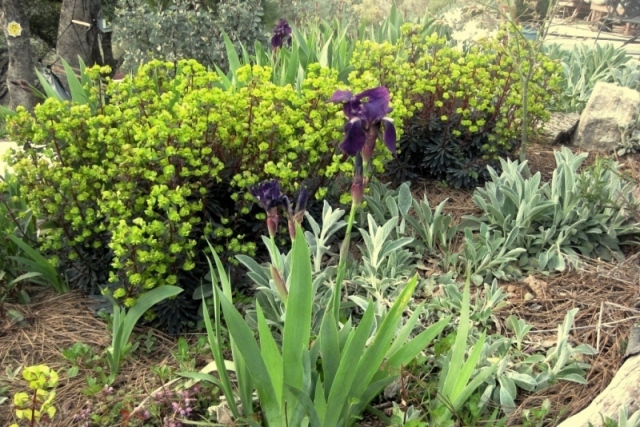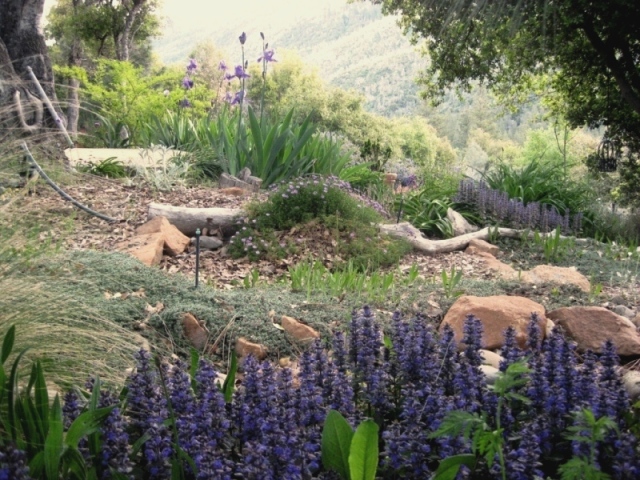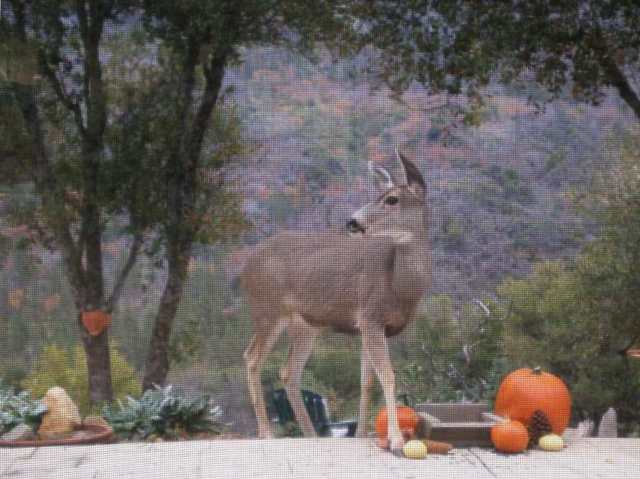Deer resistant plants for a California garden
When food sources dwindle for deer in late summer and Fall, they will eat to survive, but, these plants have deterred deer in the “test garden” here in Oakhurst-Yosemite area for the last five years. Some gardeners, like me, would rather have the deer strolling through than become attached to any plants, but you will be delighted to know that it is possible to have both!
New mountain area gardeners may become discouraged when their neighbors shake their heads and say, “Oh, I can’t grow anything, but the deer eat it!” Don’t be discouraged, just try these:
(Hint- Look up any unfamiliar plants at Dave’s Garden PlantFiles Search…a great research tool!)
Acer palmatum, Japanese maple
Acer negundo, Box Elder
Achillea, Yarrow
Agastache, Anise hyssop, Hummingbird mint
Ajuga, Carpet bugle
Allium, Wild onion
Aquilegia formosa, Western Columbine

Artemisia
Asclepias, Butterfly weed
Asters
Berberis thunbergii, Barberry
Berlandiera lyrata, Chocolate Scented Daisy
Brachycome multifida, Rock Daisy
Buddleia, Butterfly bush
Campanula, Bellflower
Carpenteria, California anemone
Ceanothus, Wild lilac
Cerastium tomentosa, Snow-in-Summer
Centranthus ruber, Jupiter’s beard
Chamaecyparis, False Cypress

Chrysanthemum parthenium, Golden feverfew
Cercis occidentalis, California Redbud
Cistus, Rockrose
Chrysanthemum maximum, Shasta Daisy
Chrysanthemum paludosum, Ox-eye Daisy
Coreopsis, Tickseed
Cotoneaster
Dahlia
Delphinium
Diascia, Twinspur
Dicentra formosa, Western bleeding heart
Digitalis, Foxglove
Dudleya cymosa Hen & Chicks
Echinacea, Cone flower
Epilobium, California fuschia
Erigeron karvinskianus, Mexican daisy
Erysimum, Wallflower
Eschscholzia californica California Poppy
Euphorbia, Spurge
Ferns
Gaillardia grandiflora, Indian Blanket
Grass and grass-like plants
Helichrysum
Helleborus, Hellebores
Hemerocallis, Day lily
Heuchera, Coral Bells
Hypericum, St. Johnswort
Hyssopus, Hyssop
Iris
Laurentia fluviatilis, Blue Star Creeper
Lavandula, Lavender
Lilium, Asiatic Lily
Lonicera, Honeysuckle
Lupinus albifrons, Silver bush lupine
Lysimachia nummularia, Creeping Jenny

Mahonia, Oregon grape
Mentha, Mint
Miscanthus sinensis, Maiden Grass
Monarda didyma, Bee Balm
Monardella, Coyote mint
Myrtus, Myrtle
Narcissus, Daffodils
Nepeta, Catmint
Nigella damascena, Love in a Mist
Nicotiana, Flowering tobacco
Origanum, Oregano
Oxalis oregana, Redwood sorrel
Papaver, Poppy
Peony
Perovskia, Russian sage
Phlomis, Jerusalem sage
Phlox subulata, Creeping Phlox
Picea glauca, Alberta Spruce
Potentilla, Cinquefoil
Pyracantha, Firethorn
Rhododendron
Romneya coulteri, Matilija poppy
Rosmarinus, Rosemary
Rudbeckia hirta, Gloriosa Daisy

Sage
Salvia apiana, White sage
Salvia ‘Bee’s Bliss’
Salvia clevelandii, Cleveland sage
Salvia leucophylla, Gray sage
Salvia mellifera, Black sage
Salvia sonomensis, Sonoma sage
Salvia spathacea, Hummingbird sage
Santolina, Lavender cotton
Sedum
Senecio, Dusty miller
Sisyrinchium bellum, Blue-eyed grass
Solanum, Potato vine
Spiraea, Spirea
Stachys, Lamb’s ears
Syringa vulgaris, Common Lilac
Tagetes lemmonii, Mexican bush marigold
Teucrium, Germander
Thymus, Common thyme
Umbellularia californica, California bay
Verbascum, Mullein
Verbena bonariensis, Tall Verbena
Veronica, Speedwell
Vitex agnus-castus, Chaste tree
Good sources for these plants are the Western Sierra Nursery in Oakhurst and Intermountain Nursery in Prather, both in the Mountain Area .





Pingback: - The Latest Of Living On A Mountain